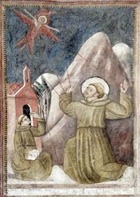

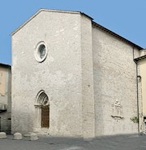
The Franciscans settled near the first walled settlement of Gualdo, in Valdogorgo, perhaps at the behest of St Raynaldus, who was an admirer of St Francis and who was Bishop of Nocera (and hence of Gualdo) in 1213-7. The Commune gave them the nearby Eremo di SS Stefano e Lorenzo (later the Eremo di San Marzio). According to the 14th century Leggendario di San Francesco, St Francis himself stayed with his brothers here (traditionally in 1224).
Fire destroyed this first settlement in 1237, and it was rebuilt on the current site in the 1240s. The Franciscans decided to return Eremo di SS Stefano e Lorenzo to the Commune and to build a new church and convent on land donated to them in 1241 by a nobleman called Oddo. There was some uncertainty as to the location of this site: Ruggero Guerrieri (referenced on the home page of Gualdo Tadino) believed that it was on the present site, albeit that the Convento di San Francesco di Gualdo was first documented only in 1288. Its church was consecrated in 1315 in the presence of the bishops of Assisi, Cagli, Città di Castello, Gubbio, Jesi, Nocera and Perugia.
In 1766, the commendatory abbot of San Donato opposed a request by the friars to move the relics of the Blessed Martius from San Rocco (which was at that time under his administration) to San Francesco. They thwarted his intention to translate them to San Donato by taking them, without authorisation, to their church. Most of the relics were translated to the Altare del Rosario of San Benedetto in 1907, while the tibia was translated to the Chiesa dell' Assunzione di Maria Vergine, Pieve di Compresseto (where it can be seen under the high altar).
The complex was suppressed in 1871 and its surviving works of art formed the basis of the new civic art collection. The church was restored in 1955-60, after which it housed the Pinacoteca Comunale until 1979. The convent has been demolished.
Exterior
A number of donations are recorded in the late 15th century for the building or rebuilding of the campanile, and a payment was made for the work in 1490.
The upper part of the campanile fell during the earthquake of 1751, badly damaging part of the church.
The upper part of the main facade and part of the right wall were also destroyed.
The façade retains the original rose window and portal, albeit that the latter required radical restoration in 1919.
Interior
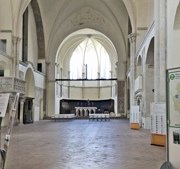
The interior is in the form of a single nave in three bays and a semi-circular apse.
The raised pulpit (13th century) on the left was commissioned by Jacopo and Simone di Finaguerra (according to the inscription).
The relics of the Blessed Maio were venerated under the pulpit (13th century) on the right.
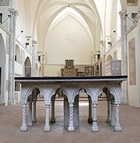
Frescoes (15th century)
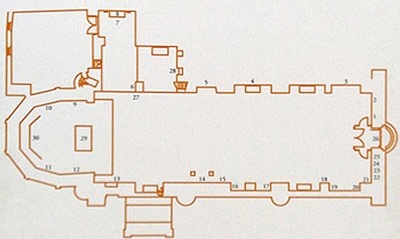
This plan in the church gives the location of the frescoes that were recovered during the restoration of the church in 1955-60.
St Bernardino of Siena (1451)
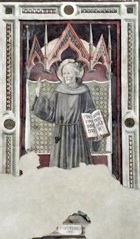
Madonna and Child with St Anne (15th century)
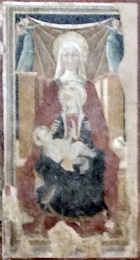
Volto Santo (1474)
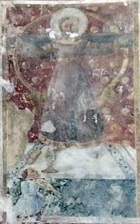
Stigmatisation of St Francis (1496)
Other Frescoes attributed to Matteo da Gualdo (15th century)
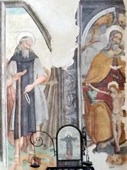
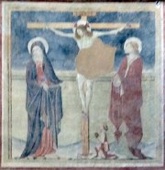

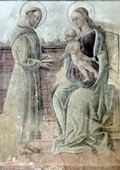
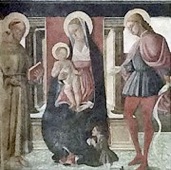
These frescoes, which are attributed to Matteo da Gualdo, depict:
-
✴St William of Maleval (or perhaps St Antony Abbot), who stands on a dragon and the adjacent fragment of a representation of the Trinity (1);
-
✴the Crucifixion with the Virgin and St John the Evangelist and a kneeling male donor (10), although the attribution here is tentative;
-
✴St Nicholas of Tolentino (16), which is missing its head although this work is not included in the catalogue of Sara Giuliani Spurney, referenced in the page on the artist);
-
✴St Francis presenting the Franciscan Rule to the Madonna and Child (17)
-
✴the Madonna and Child enthroned with SS Francis and Secundus, with a kneeling male donor (23).
Frescoes attributed to Girolamo di Matteo da Gualdo (15th century)
These frescoes in San Francesco that are attributed to Girolamo di Matteo da Gualdo, depict:
-
✴ SS Martin and Roch (13); and
-
✴SS Sebastian, Peregrine, Maichael and Roch (14).
Art from the Complex
Christus Patens (13th century)
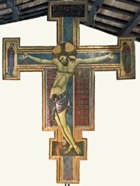
I(ESUS C(RUSTUS) NAZARENU(S)
REX IUDEORU(M)
Jesus Christ of Nazareth, King of the Jews
The crucifix, which was restored in 1919 and again in 1938, is now in the Pinacoteca Comunale. Its relationship to other contemporary Franciscan crucifixes is a matter of debate: the gallery attribution is to the otherwise unknown Maestro del Crocifisso di Gualdo Tadino.
San Francesco Polyptych (1471)
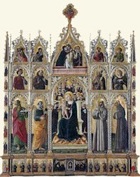
The main panels depict
-
✴the Madonna and Child enthroned with angels;
-
✴SS Paul and Peter on the left; and
-
✴SS Francis and Bernardino of Sienna on the right.
The other panels depict, from left to right:
-
✴in the upper register:
-
•St Christopher, with the baby Jesus;
-
•St Clare;
-
•Christ blessing;
-
•St Stephen; and
-
•St Julian;
-
✴in the lower register:
-
•St Secondus;
-
•St Antony of Padua;
-
•the Peità with the Virgin and St John the Evangelist;
-
•St Louis of Toulouse; and
-
•St Michael.
The standing figures in the side pilasters probably depict Apostles.
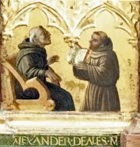
-
✴King Robert of Naples and Pope Alexander V, on the left;
-
✴Pope Nicholas IV and Cardinal Matthew of Acquasparta, on the right;
-
✴at the extreme, the delightfully short-sighted Fr Alexander of Hales, who reads from a book held for him by a young friar (illustrated here).
God the Father with saints (ca. 1528)
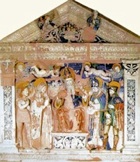
-
✴The main part of the relief depicts God the Father enthroned with the Virgin and St Facondinus, flanked by the plague saints, SS Sebastian and Roch. Angels above hold the Host, representing the crucified Christ.
-
✴Figures of the Annunciation (a reference to the Holy Spirit) are inserted in the frame of the tympanum.
-
✴The predella depicts God the Father in a tondo flanked by male and female members of the Confraternita della SS Trinità (who owned the hermitage and who presumably commissioned the altarpiece.
It is now in the Ceramic Section of the Pinacoteca Comunale.
Assumption of the Virgin (16th century)
This damaged panel in the Pinacoteca Comunale, which came from the Altare dell’ Assunta in San Francesco, is attributed to Bernardo di Girolamo di Matteo da Gualdo. It depicts the Virgin against a landscape in which St Jerome meditates on the crosses on Golgotha. God the Father and angels are represented above. The crowd that witnesses the scene is largely made up of figures in the red garb of the Confraternita della Trinità, to whom the altar belonged.
St Antony Abbot (17th century)
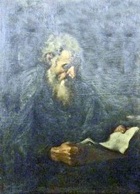
Return to Monuments of Gubbio.
Return to Walk around Gualdo Tadino.
Return to Excursions from Gualdo Tadino (Eremo di Santo Marzio)
